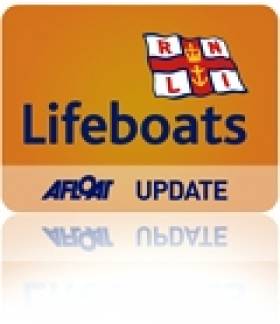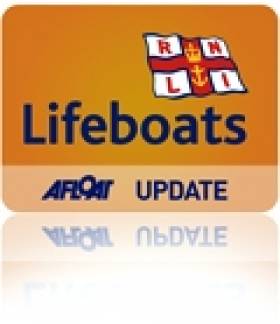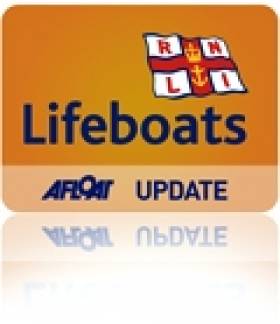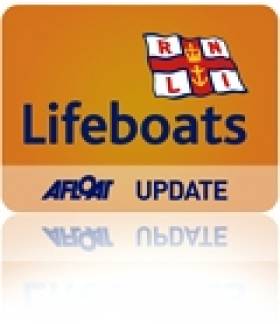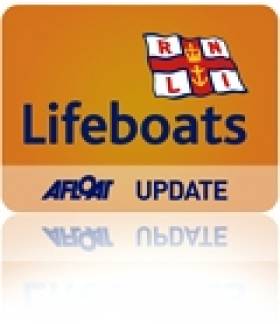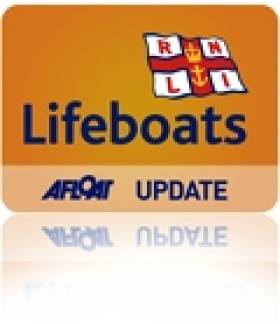Displaying items by tag: RNLI
RNLI Seeks Responses in Sea Safety Advice Survey
#SAFETY AT SEA - How do you use weather forecasts to plan your leisure time on the water?
The RNLI asks all water users in the UK and Ireland to take a quick 10-minute survey by the UK's Met Office.
Its results will help meteorologists and rescue teams to better understand sea users in order to give better water safety advice and save more lives through preventative action.
Take the survey HERE by 3 December.
Going out on the water can be a lot of fun, and is a way of life in coastal communities around the UK and Ireland. But the sea can be an unpredictable and dangerous place.
Taking some simple precautions can make your time on the water even more enjoyable, and reduce your chances of getting into trouble.
The RNLI has an interactive publication, Sea Safety: The Complete Guide, which is essential reading for anyone who finds themselves drawn to the water.
RNLI Warns Over 'Bogus Santa' Collector
#RNLI - The RNLI has warned the public in Donegal to keep on the lookout after reports that a man in a Santa Claus outfit was falsely claiming to be collecting for the lifeboat charity at the weekend.
A spokesperson for the RNLI told the Donegal Democrat that Gardaí in Bundoran were alerted to a man soliciting donations throughout the popular surf town on Saturday and Sunday.
The RNLI confirmed that it has no collections going at present, though its crew members and volunteers will soon be selling tickets to a fundraising dinner dance in February 2013.
RNLI Bundoran adds:
Bundoran RNLI Lifeboat are today (Monday 19th November) warning members of the public to be aware of a man dressed in a Santa suit claiming to be doing a collection on behalf of the organisation in the local area.
Members of the voluntary organisation were made aware of the character on Sunday evening after a member of the public said that he had called to his house in the West End of the seaside resort. The Gardai were immediately notified and an alert issued to the public via the lifeboat station's social media pages.
Volunteer Fundraiser for Bundoran RNLI Lifeboat, Cormac McGurren said 'this news is particularly disturbing in this day and age and we would encourage anybody who is approached by this man to refuse to hand over any money to him and report him immediately to the local Gardai. Members of the RNLI doing any collection will always be carrying official RNLI branded buckets and wearing official clothing. We will shortly commence selling tickets for our annual dinner dance at the start of February but I can confirm that we currently have no collections operating in the Bundoran & Ballyshannon area'
Lifeboat Press Officer Shane Smyth added 'the RNLI is a very respected and trusted organisation in the area and we are constantly relying on the generosity of locals to keep the service funded year round so that we can save lives at sea. An incident such as this is particularly unhelpful and we would ask people to be vigilant'
Dunmore East Volunteer is RNLI Photographer of the Year
#RNLI - Neville Murphy of Dunmore East lifeboat station has been named the RNLI's Photographer of the Year for 2012.
The public came out in force on Facebook to vote for 'The Calm', his shot of heavy weather jackets hanging in the locker room at the Waterford station as the best out of 12 stunning images selected for the shortlist.
Murphy, a native of Skibbereen in Co Cork, has been on the all-weather lifeboat crew fat Dunmore East for 10 years since his job as a winch man with the Irish Coast Guard brought him to Waterford.
See a gallery with the winning photo and the runners up HERE.
Help Choose a Winner for RNLI Photographer of the Year
#LIFEBOATS - The shortlist has been announced for the RNLI's annual Photographer of the Year competition - and for the first time in its seven-year history, the charity is inviting members of the public to vote for their favourite.
The shortlist is now online via the RNLI Facebook page, and voting remains open till 5pm on Monday 12 November.
Among the 12 shortlisted snapshots is this stark image from the locker room at the Dunmore East lifeboat station, photographed by volunteer lifeboat crew member Neville Murphy.
You can help celebrate the work of the RNLI's volunteers by voting for your favourite image before the deadline!
RNLI Receives Thank-You After Cow Rescued from Irish Sea
#LIFEBOATS - The volunteer lifeboat crew at Trearddur Bay in Anglesey, north Wales have received a kind donation and a thank-you card from the owner of Daisy, a cow recently rescued after falling from a cliff into the Irish Sea.
Danielle Bosustow, aged eight, was so touched that the crew had rescued her pet she put pen to paper to thank them. Her thank you card reads: "Thank you so much for your help rescuing my cow Daisy. I am so happy to see her again."
Along with the thank you card was a kind donation from Danielle’s grandfather, a local farmer who visited the station to show his gratitude to the RNLI.
The volunteer crew sprung into action on 22 October last, following reports that a cow had fallen from a cliff at Porthdafarch.
The lifeboat launched and with the help of the local farmer, Daisy was located and towed to safety using a bridle. She was taken to a bay close by where she could safely reach dry land.
Alf Pritchard, press officer for Trearddur Bay RNLI said: "We were shown some photographs which were taken after Daisy’s ordeal and it was good to see she is none the worse for her experience.
"It’s so nice when people come back to let you know that what you have done is appreciated. As a charity, the RNLI also very much appreciates the donation."
Isle of Man Lifeboat Volunteers Recognised by Queen
#LIFEBOATS - Volunteers with Douglas RNLI in the Isle of Man were presented with Diamond Jubilee medals from the Queen last week in recognition of their tireless service to saving lives in the Irish Sea.
And they couldn't have found a better place to present them than the Fort Anne, the former home of RNLI founder Sir William Hillary.
The medal recipients included lifeboat crew Neal Corran (Coxswain); Juan Howland (Emergency. Cox); Tony Radcliffe (Mechanic); Peter Cowin (Emergency Mechanic); Donald Bottomley Emergency Mechanic); Simon Bushe (Emergency Mechanic); Peter Washington (Emergency Mechanic); Emily Heaton; Richard Coase; J Noel Farrell; Mark Versluijs; Richard Forrest; Graeme Cushnie; and Nigel Smallwood; plus shore crew Mary Corran (LOM); Paul Cunningham (Head Launcher); Alex McBride (Winch Operator); Robert Corran MBE; John McCreadie; and Paul Zywicki.
Surfers Train as Lifeguards in Jersey
#RNLI - In what seems like a perfect match of skills, BBC News reports on a group of five surfers from Jersey who are being trained as lifeguards by the RNLI.
The surfers have graduated from voluntary beach patrols to learning about hazard awareness, accident prevention, first aid and open water rescue skills, according to RNLI lifeguard supervisor Rob Stuteley.
It's hoped that the scheme will "play a big part in encouraging more local people to sign up to join the RNLI lifeguard team for 2013".
And maybe it will provide some inspiration for surfers and lifesavers around the Irish coast, too!
Boys Rescued From Rocks Off North NI Coast
#LIFEBOATS - Two teens were rescued from rocks off north Co Derry on Wednesday afternoon, the Belfast Telegraph reports.
The 13-year-old boys were stranded by the incoming tide in the East Promenade area of Portstewart.
PSNI officers called to the scene around 4.30pm managed to persuade one of the boys to cross to the shore, but the coastguard was tasked to lift the other boy from the rocks by the RNLI, according to UTV News.
Police inspector Mick Wood said that the incident "serves as a reminder to us that tides are extremely unpredictable".
Castletownbere Lifeboat Assists Grounded Spanish Trawler
#rnli – Castletownbere lifeboat crew responded to an early morning callout on Saturday when they launched at 5am to reports that a Spanish fishing trawler had grounded at Ard na Kinna on the western point of Bere Island in Cork. The 33 metre vessel had eleven crewmembers onboard.
The Castletownbere lifeboat under Coxswain Brian O'Driscoll pulled up alongside the grounded vessel and assisted some of the crew onboard the lifeboat. Images taken from the RNLI lifeboat camera show the transfer and the crew were safely evacuated. They had not sustained any injuries during the incident.
Commenting on the callout Paul Stevens Castletownbere RNLI lifeboat press officer said, "None of the crew were in any immediate danger but for their own safety we evacuated them from the grounded vessel. They are very fortunate that they sustained no injuries and that conditions were excellent at the time of the grounding."
The vessel was successfully refloated at 4pm yesterday.
Late Night Mayday Response for Holyhead RNLI
#LIFEBOATS - Holyhead RNLI's all-weather lifeboat was dispatched late on Wednesday night (24 October) in response to a distress call from a yacht in the Irish Sea.
The volunteer crew received the request from Holyhead Coastguard after a mayday call from the skipper of a 24-yacht off the northwest coast of Anglesey in North Wales.
The man, who was the only person aboard the vessel, was on his way to the Canary Islands when he made the call for assistance.
A helicopter from RAF Valley stood by the casualty until the lifeboat crew arrived to rescue him and tow his vessel back to Holyhead.
The yacht reportedly started to sink as it was towed into Holyhead harbour, but the lifeboat crew managed to secure the vessel alongside the boatyard slip.



























